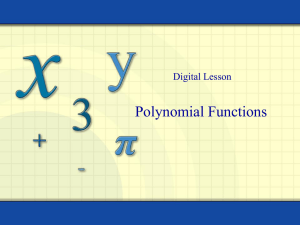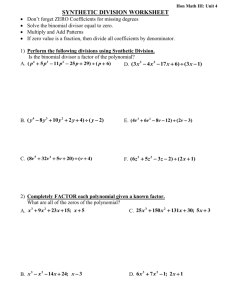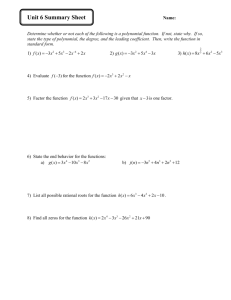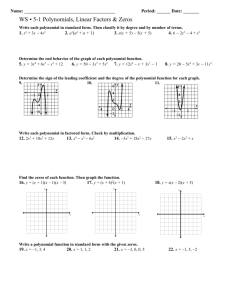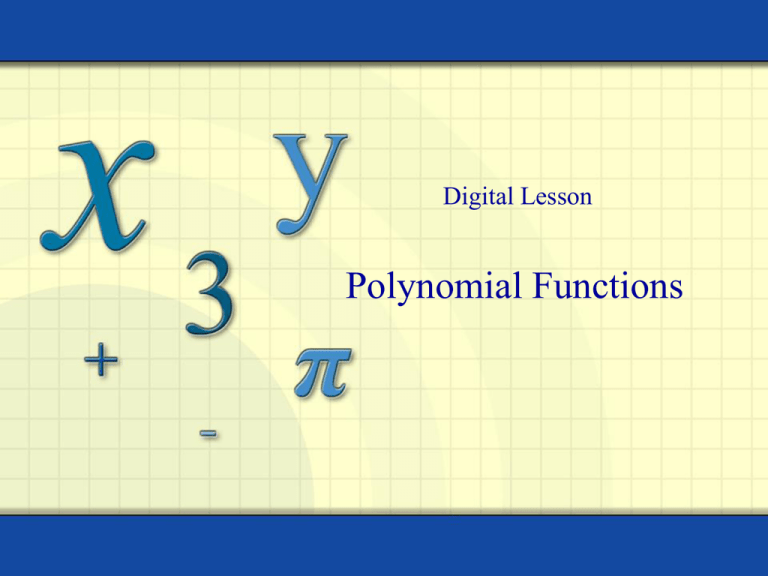
Digital Lesson
Polynomial Functions
A polynomial function is a function of the form
f ( x) an x n an1 x n1
a1 x a0 , an 0
where n is a nonnegative integer and each ai (i = 0, , n)
is a real number. The polynomial function has a leading
coefficient an and degree n.
Examples: Find the leading coefficient and degree of each
polynomial function.
Polynomial Function
f ( x) 2 x5 3x3 5x 1
Leading Coefficient
Degree
–2
5
f ( x) x 3 6 x 2 x 7
1
3
f ( x) 14
14
0
Copyright © by Houghton Mifflin Company, Inc. All rights reserved.
2
A real number a is a zero of a function y = f (x)
if and only if f (a) = 0.
Real Zeros of Polynomial Functions
If y = f (x) is a polynomial function and a is a real number then
the following statements are equivalent.
1. x = a is a zero of f.
2. x = a is a solution of the polynomial equation f (x) = 0.
3. (x – a) is a factor of the polynomial f (x).
4. (a, 0) is an x-intercept of the graph of y = f (x).
A polynomial function of degree n has at most n zeros.
Copyright © by Houghton Mifflin Company, Inc. All rights reserved.
3
Example: Find all the real zeros of
f (x) = x 4 – x3 – 2x2.
Factor completely:
f (x) = x 4 – x3 – 2x2 = x2(x + 1)(x – 2).
y
The real zeros are x = –1,
x = 0, and x = 2.
2
(0, 0)
(–1, 0)
These correspond to the
x-intercepts.
x
–2
(2, 0)
f (x) = x4 – x3 – 2x2
Copyright © by Houghton Mifflin Company, Inc. All rights reserved.
4
Dividing Polynomials
Example: Divide x2 + 3x – 2 by x – 1 and check the answer.
x + 2
x 1 x 2 3x 2
x2 +
x
2x – 2
2x + 2
–4
remainder
Answer: x + 2 +
–4
x2
1. x x x
x
2. x( x 1) x 2 x
2
3. ( x 2 3x) ( x 2 x) 2 x
2x
4. x 2 x
2
x
5. 2( x 1) 2 x 2
6. (2 x 2) (2 x 2) 4
x 1
Check: (x + 2) (x + 1) + (– 4) = x2 + 3x – 2
quotient divisor remainder
Copyright © by Houghton Mifflin Company, Inc. All rights reserved.
dividend
5
Synthetic division is a shorter method of dividing polynomials.
This method can be used only when the divisor is of the form
x – a. It uses the coefficients of each term in the dividend.
Example: Divide 3x2 + 2x – 1 by x – 2 using synthetic division.
Since the divisor is x – 2, a = 2.
coefficients of the dividend
value of a
2
3
3
2
–1
6
16
8
15
coefficients of quotient
Answer: 3x + 8
Copyright © by Houghton Mifflin Company, Inc. All rights reserved.
1. Bring down 3
2. (2 • 3) = 6
3. (2 + 6) = 8
4. (2 • 8) = 16
5. (–1 + 16) = 15
remainder
15
x2
6
Remainder Theorem: The remainder of the division of a
polynomial f (x) by x – k is f (k).
Example: Using the remainder theorem, evaluate
f(x) = x 4 – 4x – 1 when x = 3.
value of x
3
1
1
0
0
–4
–1
3
9
27
69
3
9
23
68
The remainder is 68 at x = 3, so f (3) = 68.
You can check this using substitution: f(3) = (3)4 – 4(3) – 1 = 68.
Copyright © by Houghton Mifflin Company, Inc. All rights reserved.
7
Factor Theorem: A polynomial f(x) has a factor (x – k) if and
only if f(k) = 0.
Example: Show that (x + 2) and (x – 1) are factors of
f(x) = 2x 3 + x2 – 5x + 2.
–2
2
2
1
–5
2
–4
6
–2
–3
1
0
1
2
2
–3
1
2
–1
–1
0
The remainders of 0 indicate that (x + 2) and (x – 1) are factors.
The complete factorization of f is (x + 2)(x – 1)(2x – 1).
Copyright © by Houghton Mifflin Company, Inc. All rights reserved.
8
Rational Zero Test: If a polynomial f(x) has integer coefficients,
every rational zero of f has the form
rational zero =
p
q
where p and q have no common factors other than 1.
• p is a factor of the constant term.
• q is a factor of the leading coefficient.
Example: Find the rational zeros of f(x) = x3 + 3x2 – x – 3.
q=1
p=–3
The possible rational zeros are ±1 and ±3.
Synthetic division shows that the factors of f are (x + 3), (x + 1),
and (x – 1).
The zeros of f are – 3, – 1, and 1.
Copyright © by Houghton Mifflin Company, Inc. All rights reserved.
9
Descartes’s Rule of Signs: If f(x) is a polynomial with real
coefficients and a nonzero constant term,
1. The number of positive real zeros of f is equal to the number
of variations in sign of f(x) or less than that number by an
even integer.
2. The number of negative real zeros of f is equal to the
number of variations in sign of f(–x) or less than that number
by an even integer.
A variation in sign means that two consecutive, nonzero
coefficients have opposite signs.
Copyright © by Houghton Mifflin Company, Inc. All rights reserved.
10
Example: Use Descartes’s Rule of Signs to determine the
possible number of positive and negative real zeros of
f(x) = 2x4 – 17x3 + 35x2 + 9x – 45.
The polynomial has three variations in sign.
+ to –
+ to –
f(x) = 2x4 – 17x3 + 35x2 + 9x – 45
– to +
f(x) has either three positive real zeros or one positive real zero.
f(– x) = 2(– x)4 – 17(– x)3 + 35(– x)2 + 9(– x) – 45
=2x4 + 17x3 + 35x2 – 9x – 45
f(x) has one negative real zero.
One change in sign
f(x) = 2x4 – 17x3 + 35x2 + 9x – 45 = (x + 1)(2x – 3)(x – 3)(x – 5).
Copyright © by Houghton Mifflin Company, Inc. All rights reserved.
11
Graphing Utility: Find the zeros of f(x) = 2x3 + x2 – 5x + 2.
10
– 10
10
Calc Menu:
– 10
The zeros of f(x) are x = – 2, x = 0.5, and x = 1.
Copyright © by Houghton Mifflin Company, Inc. All rights reserved.
12

